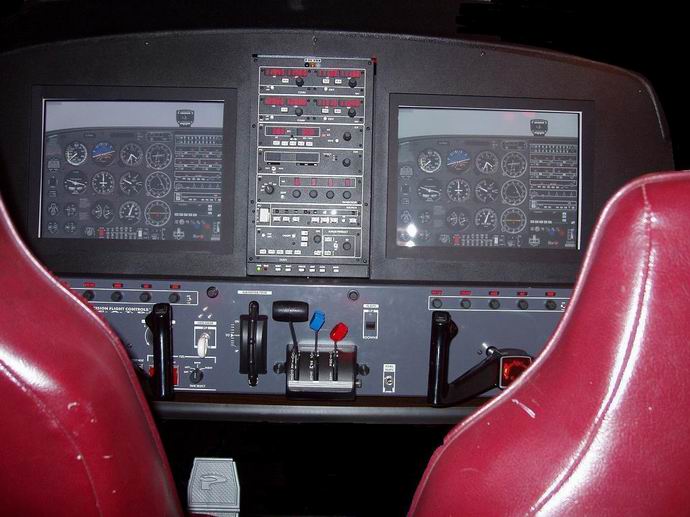Mobile Flight Simulators
features the PI-142 two place general aviation simulator from
Precision Flight Controls powered by software from
Elite Simulation Solutions.
The PI-142's resistance loaded yoke and rudder pedals offer the feel of a real aircraft. The panel provides all common control switches for ignition, lights, flaps, fuel selector, pitot heat, etc. so procedures can be performed from start-up to shut-down. The integrated communications tower supports dual nav-coms, VOR/DME, ADF, S-Mode transponder, auto pilot, and an approach approved GPS.

The Elite software provides you with your choise of several popular aircraft, each with a number of different avionics configurations. Flight models are derived from actual flight data to be accurate in every respect. Simulated aircraft include:
- Single Engine Aircraft:
-
- Cessna 172R
- Cessna 182S
- Cessna 182RG
- Piper Archer III
- Piper Arrow IV
- Beechcraft Bonanza A36
- Mooney M20J
- Socata Trinidad TB-10
- Socata Trinidad TB-20
- Multi-Engine Aircraft:
-
- Piper Seneca III
- Beechcraft Baron 58
- Beechcraft King Air B200 Turbo
A separate instructor station (incorporated into the right seat) tracks the training session in real time on a moving map and flight profile graphs. From the instructor station all aspects of the training environment are controlled including:
- Weather:
-
- Visibility
- Ceiling
- Wind
- Turbulence
- Pressure
- Temperature
- Weather parameters can be static or dynamic and vary by altitude
- Airframe icing can be forced or allowed to occur based on conditions
- Malfunctions:
-
- Instruments
- Receivers
- Engine(s)
- Electrical System
- Mechanical Systems
- Failures can be immediate or gradual, partial or complete
- Can be forced or "armed" to occur within a time window
- Can be combined to simulate multiple failures
- Can be activated randomly by the computer
The integrated navigational data base encompasses all of North America. It contains all airports, fixes, NDB's, VOR's, and localizers along with the corresponding communication data.
Pre-programmed ATC scenarios simulate real life instrument approaches. Follow the controller's instructions closely to experience the satisfaction of seeing the runway threshold appear out of the soup. If you don't, are you ready to execute a missed approach? How good are you with holding patterns? In a cross wind? What about a last minute change to the active runway? These and other challenges can help you to be better prepared for this critical part of a flight.
Virtual Flight Instructor (VFII) is an add on program that is included with your rental. It is a scenario based instruction and evaluation program that guides you through all the elements of the FAA Instrument Rating Practical Test. Learn IFR procedures as they are applied in the real-world, as if flying within the ATC system. The virtual instructor introduces each lesson and it goals. Upon completion of each flight, your execution is evaluated and graded. Lessons may be done progressively or you can choose the specific skill you want to work on. Whatever your current rating, VFII will help you improve your piloting skills.
The MFS
simulator is certified as a Basic PCATD under FAA Advisory
Circular 61-126. As such it may be used to log 2.5 hours
toward a private pilot certificate [61.109(i)(1)], 10 hours
toward an instrument rating [61.57(c)(1)], and to maintain
instrument currency [61.65(e)(2)].
To qualify as loggable, time must be performed with a certifed
instructor as part of an approved training program.